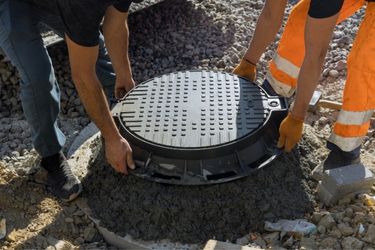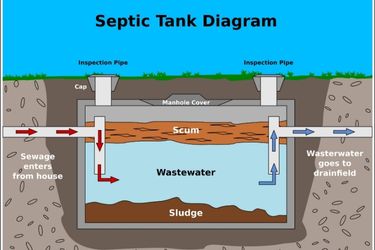
Written by Kayla Jane Barrie Updated on Mar 03, 2025 5 mins read

A septic tank plays an essential role in your home. If you are a homeowner with a septic tank, you may be wondering if your policy can help in the event it’s damaged.
If your home has a septic tank, it’s imperative to know how they work and understand the appropriate maintenance protocols. You also need to know if you have home insurance and the limits in place. If there are unforeseen issues with it, you may be on the hook to pay for all repairs or replacements. Replacing a septic tank can cost up to $5,000 (or more!) depending on many factors.
In this blog, we’ll flush out how septic tanks work, how to support their longevity with proper maintenance, and if insurance can help you if there are repairs or damages.
A septic tank is a contained waste system made of steel, fibreglass, or concrete that is placed underground in your yard or beside the house. It is designed to hold and treat sewage and wastewater.
If you live in a rural area that is far from municipal services, you will likely have a septic tank. They are used in situations where homes cannot be connected to centralized sewer systems. Since septic tanks deal with those elements, it’s worth including additional coverage such as insurance for water damage.
Septic tanks move materials through pipes underground into the tank, where wastewater and solid materials are separated. The water is released from the tank into the surrounding soil, and waste is collected until it is pumped out during yearly maintenance.
Thanks to gravity, the sludge (solids) goes to the bottom, scum (grease) ends up at the top, and effluent (watery mix) ends up in the middle. The sludge and scum need to be cleaned from the septic tank to ensure the water keeps flowing smoothly. If it is not cleaned, it can cause issues like sewer backup.
Most policies include protection for structures such as septic tanks, pools, or fences. If your septic tank experiences a sudden accident, such as falling objects, electrical, fire, or weather-related issues, you should be covered by home insurance in Canada. You will likely be asked by your insurer if you have a septic tank when you get a quote.
Your septic tank coverage will be a percentage of your total policy limit. For example, your policy limit may be around 10% of what your entire home is insured for. Let’s say your home is insured for $400,000 – your septic tank would be covered for up to $40,000. That should be enough to repair or replace a tank if the damages are caused by an accident.
It’s crucial to understand there are limitations within your policy where these additions may not be covered, which is why it’s important to connect with your insurer if you have any questions about your plan, and if you should add any endorsements.
If a problem can be traced back to human error and poor maintenance, your policy will likely not cover your claim. Some examples include:
Policies will specifically declare what is not covered and what could be prevented by maintenance and proper construction. If you have any questions about how your septic tank impacts your home insurance in Ontario, contact ThinkInsure today.

If a septic tank requires repair due to a sudden event or accident, then it may be covered depending on your policy. It may also include damages caused to your home by a septic tank leak. If the repair could have been prevented or was caused by neglect, you will likely not be covered for repairs.
If you need to submit a claim related to your septic tank, be sure to document the area and be ready to provide proof, such as photos, that the issues were caused by a sudden accident. It’s also good to have receipts that prove you are committed to proper maintenance and inspection. Once you have your documents and policy handy, contact your insurer and begin the process of submitting a home insurance claim.
If you have a septic tank or are planning to buy an older home with one, you will need to be mindful of how much water you are using so you don’t overwhelm the system. Below are some more pros and cons of having a septic tank:
Pros
Cons
One of the most common questions homeowners ask is how often they should pump a septic tank. The answer is that it depends.
Pumping annually is good practice, but depending on tank levels, you may get it cleaned every two to three years. To find out if you need to get it pumped, you can contact a certified professional, or you can locate and carefully remove the septic tank lid. If you notice the scum has reached six inches thick, it is likely time to schedule a pump.
Most of the damage caused to septic tanks is caused by wear and tear and human error. If you have a septic tank, it’s important to follow proper maintenance and take precautions. To prevent damage:
Routine inspections are critical to prolonging the tank and avoiding costly repairs. Aim to have it inspected once a year, pumped every 1-3 years (depending on the size and tank levels), and put heavy objects such as vehicles directly over buried parts of the system.
Don’t forget to keep track of all the work you’ve done on your septic tank! This can help if you ever need to make a claim and assist with the scheduling of maintenance.
If the septic tank collapses due to an unforeseen incident or accident, you may be covered under home insurance, depending on your limits and the specifics that are outlined in your agreement. You may need to add additional insurance endorsements to ensure you have adequate coverage.
Depending on the type, size, and materials, a septic tank can cost between $2,000 and $10,000. You will also need to consider building materials, plumbing, and construction costs, along with the tank itself.
If you are buying a home, a home inspection should confirm if you have a septic tank. Other signs will be how close your home is located to municipal water – most subdivisions or busy neighbourhoods are connected to sewers. You can also call your local water management agency to confirm.
With daily use and proper care, septic tanks will generally not freeze. If the system is not in use for prolonged periods, it may be at risk of freezing.
Even though there are no specific policies for septic tanks, your home insurance should include aspects related to your tank if there is one on the property. Be sure to read your documents thoroughly and ask any questions.
| Categories | Home |
|---|---|
| Tags | Protect Your HomeHome MaintenanceHome Coverage |
Read our insurance blog to get helpful tips, information and news.
Has your car been totalled in an accident? Is your car a write off? Learn about vehicle write offs for a total loss insurance claim.
Get the facts on Toronto's auto theft problem. We break down the data, reveal the most-stolen vehicles (including the Honda CR-V and Lexus RX 350), and show which neighbourhoods are most affected.
Dive into the world of auto theft with our blog on the most stolen cars in Canada. See the most stolen cars across Canada, including provincial lists for Ontario and Quebec, and learn how high-risk models can affect your car insurance premiums.
Drive safe this winter! Check out these tips for driving in snowy and icy conditions in Ontario. Get other helpful info and FAQs on winter driving.